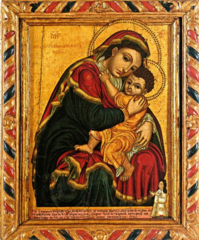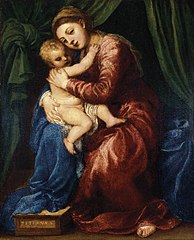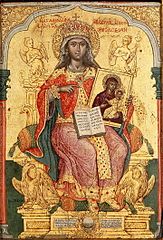Virgin Glykofilousa with the Akathist Hymn (Tzangarolas)
| Virgin Glykofilousa with the Akathist Hymn | |
|---|---|
| Greek: Παναγία Γλυκοφιλούσα με τον Ακάθιστο Ύμνο, Italian: Vergine Glykofilousa con l'inno acatista | |
Heptanese School | |
| Subject | Virgin and Child with the Akathist Hymn depicted as images |
| Dimensions | 92 cm × 65 cm (36.2 in × 25.5 in) |
| Location | Monastery and Museum of Saint Andrew, Kephalonia, Greece |
| Owner | Monastery and Museum of Saint Andrew |
The Virgin Glykofilousa with the
The
The central portion of The Virgin Glykofilousa with the Akathist Hymn closely resembles an earlier painting created by Titian. Many Greek painters were influenced by Venetian painting namely in Crete and the Ionian islands. Tzangarola's student Andreas Karantinos created three works similar to his teacher's painting. Two of them are in very good condition. The Virgin Glykofilousa (Karantinos) and the Panagia Sami. The Virgin Glykofilousa with the Akathist Hymn is part of the collection of the Monastery and Museum of Saint Andrew in Kephalonia. The painting is frequently exhibited all over the world.[4][5]
Description
The Virgin Glykofilousa with the Akathist Hymn is an egg tempera painting with gold leaf on a wood panel. The height is 92 cm (36.2 in) and the width: 65 cm (25.5 in). The work was completed in 1700. The work exhibits a mixture of the Greek Baroque, Late Cretan School, and the Rococo. Both Emmanuel Tzanes and Ioannis Moskos implemented stylistically similar elements the Rococo decorative gold background was common two both artists. Tzangarola decorated his work with complex rococo patterns namely above the Virgin's head. On the same ornate Rococo decoration, two seraphim appear to our left and right. Below the decoration are the classic symbols ΜΡ ΘΥ. Τhe letters ΜΡ ΘΥ are short for ΜΗΤΗΡ ΘΕΟΥ, it means Mother of God. The Greek symbols are on countless Greek and Italian paintings.[6]
The Virgin and Child appear in the traditional glykophilousa (Virgin of the sweet kiss) or the
The Virgin and Child are weightless figures floating in space. The young majestic boy relays innocence, charm, and charisma. His reddish curly hair is the same color as the Theotokos. His small hand embraces his mother as she tightly holds her child. His right foot is arched as it rests on her garment. The Virgin's garment is painted in rich detail and color and is gracefully arranged in loose folds. The gold trim of her sumptuous gown is representative of the celestial realm from which she has descended.
Twenty-four scenes surround the heavenly figures. Each scene depicts a pictorial story of the
Gallery
-
In Thee Rejoiceth Klontzas
-
Virgin Glykofilousa Karadinos
-
Panagia Samis Karadinos
-
Madonna Col Bambino Titian
Rococo
References
- ISBN 960-7916-00-X.
- ^ Eugenia Drakopoulou (February 8, 2022). "Tzankarolas Stefanos". Institute for Neohellenic Research. Retrieved February 8, 2022.
- ^ Katselakì, Andromache (1999). Εικόνα Παναγίας Γλυκοφιλούσας από την Κεφαλονιά στο Βυζαντινό Μουσείο [An Icon of the Panagia Glykophilousa from Kephalonia in the Byzantine Museum]. Athens: Journal of the Christian Archaeological Society ChAE 20 Period Delta. p. 380.
- ISBN 9780892415175.
- ^ Katselakì, 1999, pp 378-380
- ^ Katselakì, 1999, p 381
- ^ Protosyggellos I.M. Alexandroupolis (April 16, 2021). "The Standing Hymn". Alexandroupoli Online. Retrieved February 8, 2022.






